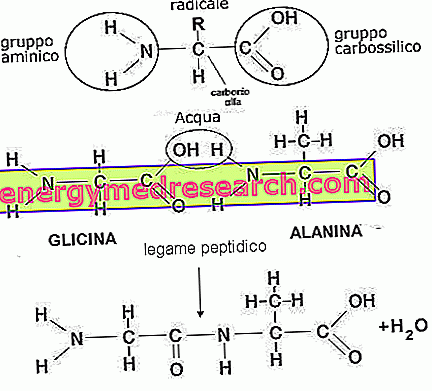Proteins
Proteins are polymeric molecules composed of more than 100 amino acids bound by peptide bonds (shorter amino acid chains are called polypeptides or peptides); the structure of proteins can be more or less long, folded back on itself and fixed to other molecules (factors that determine its complexity and characterize its biological function). These structures can be classified into: primary structure, secondary structure (α-helix and β-leaflet), tertiary structure and quaternary structure.


Protein functions
In nature, proteins perform many functions and the most famous is undoubtedly the structural one; just think that every tissue matrix of our organism is based on a skeleton or polymeric mosaic formed by peptides (eg muscle fibers, bone matrix, connective tissue and, from a certain point of view, even blood).
No less important is the function of bio-regulation and chemical / hormonal mediation, in fact proteins are the basic constituents of both enzymes and many hormones.
In blood, proteins also play a very important transport function; this is the case of hemoglobin (oxygen transport), transferrin (transport of iron), albumin (transport of lipid molecules), etc.
Still within the circulatory stream, proteins prove useful as an immune defense; they constitute ANTICORPI, essential molecules produced by lymphocytes useful in the response of the organism against pathogens.
Finally, proteins - but more precisely amino acids - can be used for energy purposes by means of hepatic neoglucogenesis and provide 4 kilocalories (kcal) per gram. It is a fairly complicated process that, through transamination and deamination, allows the body to produce glucose under hypoglycemic conditions (possibly induced by fasting, particularly intense and / or prolonged muscular effort, pathological conditions or adverse clinical conditions, etc.). Some neoglucogenic amino acids can also be ketogenic so their conversion determines the release of acid molecules called ketone bodies.
NB. The energy function of proteins should be marginal and subordinate to that of sugars and fats.
Amino acids
Amino acids are quaternary molecules composed of carbon, hydrogen, oxygen and nitrogen. More than 500 types are known and their combination differentiates innumerable forms of peptides. The ordinary ones, the L-amino acids, are 20: alanine, arginine, asparagine, aspartic acid, cysteine, glutamic acid, glutamine, glycine, histidine, isoleucine, leucine, lysine, methionine, phenylalanine, proline, serine, threonine, tryptophan, tyrosine and valine . From the metabolism of the latter it is possible to obtain a wide range of non-ordinary or occasional amino acids that mainly constitute hormones, enzymes or intermediate molecules (carnitine, homocysteine, creatine, taurine, etc.).
Among the ordinary amino acids, some CANNOT be synthesized by the organism and are called ESSENTIAL; for the adult man there are 9: phenylalanine, leucine, isoleucine, lysine, methionine, threonine, tryptophan and valine . In children, there are 11 in all; to the previous ones are added: histidine and arginine .
Other classifications of amino acids are: based on the polarity of their side chains (neutral apolar, polar neutral, acid charges, basic charges) or based on the type of radical group (hydrophobic, hydrophilic, acid, basic, aromatic).
The branched chain amino acids
Among the essential ones there are also three branched-chain amino acids (BCAAs), respectively: leucine, isoleucine and valine ; the peculiarity that distinguishes the branched chain amino acids from others is represented by a different metabolic pathway of energy production.
As already explained, after transamination-deamination, most amino acids can be destined for neoglucogenesis and enter the Krebs cycle in the form of oxalacetate or pyruvate . Ultimately, if there were any real need, some of the amino acids present in the circulatory stream would enter the liver hepatocytes and exit as glucose; this is not the case for branched chain amino acids. Compared to the others, the BCAAs are DIRECTLY usable molecules from the muscles, and this peculiarity makes them much more effective in the direct energy production and in the conversion for the reconstitution of glycogen reserves; it goes without saying that, if the organism is sufficiently fed, the catabolism of branched amino acids represents an almost irrelevant neoglucogenetic portion; Glucose remains ALWAYS the primary energy source, therefore, in conditions of glycaemia and SUFFICIENT glycogen reserves, even during an ordinary athletic performance there is no reason to fear that the muscle needs a surplus of branched amino acids.



